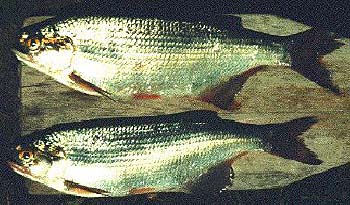Hiodon alosoides
Goldeye
Guo-Qing Li and Mark V. H. WilsonIntroduction
The goldeye, Hiodon alosoides (Rafinesque), one of only two living species in the genus, is widely distributed in the fresh waters of the interior of North America, from the Mackenzie River in the north to Louisiana in the south, and from northeastern British Columbia in the west to northwestern Quebec in the east.
Goldeye prefer turbid waters of lakes, ponds, and rivers. Food includes diverse aquatic invertebrates and small fishes, as well as other vertebrates and flying insects that fall in the water.
Goldeye live up to 17 years. Sexual maturity varies with latitude, being much earlier for fish in the south than in the north.
They are taken by both sport and commercial fishers, though they are not of great commercial importance except as a gourmet delicacy known as "Winnipeg goldeye."
Characteristics
Goldeye are silvery herring-like fishes named for their conspicuous golden iris. They differ from mooneye in that their fleshy ventral keel extends in front of the pelvic fins (Nelson, 1994). Also unlike mooneye, the dorsal-fin originates over or behind the anal-fin origin, and the mouth extends posteriorly beyond the middle of the eye. Hiodon alosoides also differs from other species in the genus in the following features:
- More vertebrae (58-63 vs. 55-58 in Hiodon tergisus and 52-53 in †Hiodon consteniorum).
- More principal anal-fin rays (31-33 vs. 26-30 in Hiodon tergisus and 18 in †Hiodon consteniorum).
- More anal pterygiophores (31-36 vs. 27-31 in Hiodon tergisus and 20 in †Hiodon consteniorum).
- Fewer principal dorsal-fin rays (9-11 vs. 11-13 in Hiodon tergisus and 13 in †Hiodon consteniorum).
- Fewer dorsal pterygiophores (10-12 vs. 13-15 in Hiodon tergisus and 14 in †Hiodon consteniorum).
In addition, Hiodon alosoides has a relatively longer predorsal length, a longer anal-fin base, a relatively lower body depth, and a shorter dorsal-fin base for its size than Hiodon tergisus.
References
Coad, B. W. (1995). Encyclopaedia of Canadian fishes. Canadian Museum of Nature, Ottawa. 928 pp.
Nelson, J. S. (1994). Fishes of the World (3rd edition). John Wiley and Sons, New York. 600 pp.
Nelson, J. S. and M. J. Paetz (1992). The fishes of Alberta (2nd ed.). University of Alberta Press / University of Calgary Press, Edmonton/Calgary. 437 pp.
See the Hiodon page for other references.
About This Page

Chinese Academy of Sciences, Beijing , China

University of Alberta, Edmonton, Alberta, Canada
Correspondence regarding this page should be directed to Guo-Qing Li at and Mark V. H. Wilson at
Page copyright © 1998 and
All Rights Reserved.
Citing this page:
Li, Guo-Qing and Mark V. H. Wilson. 1998. Hiodon alosoides. Goldeye. Version 01 January 1998. http://tolweb.org/Hiodon_alosoides/15149/1998.01.01 in The Tree of Life Web Project, http://tolweb.org/










 Go to quick links
Go to quick search
Go to navigation for this section of the ToL site
Go to detailed links for the ToL site
Go to quick links
Go to quick search
Go to navigation for this section of the ToL site
Go to detailed links for the ToL site